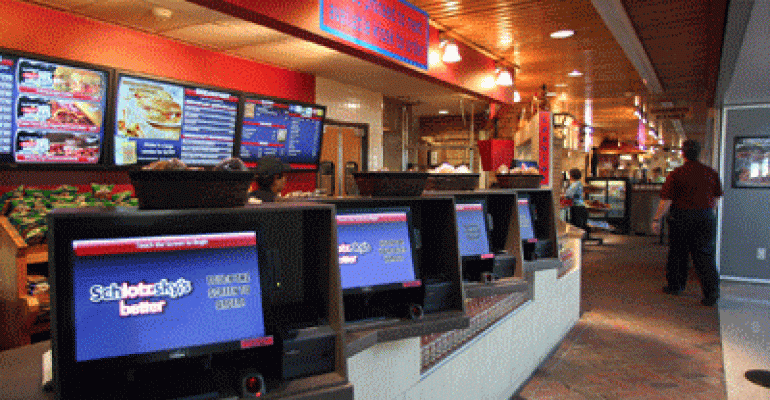Two leading airport foodservice contractors, Delaware North Cos. and HMSHost Corp., said they are building sales and increasing guest satisfaction with customer-facing technologies, such as self-order kiosks and smartphone software.
“We have focused our technology investments on installing self-service kiosks with touch-screen ordering to speed up service,” said Glen White, a spokesman for Delaware North Cos. Travel & Hospitality Services. “They have been extremely effective at several restaurants at Austin-Bergstrom International Airport in Texas since they were installed more than a year ago, and we are planning to add them at other airports.”
The Buffalo, N.Y.-based contractor has eight kiosks at three foodservice concepts in the Austin airport, including four in a Schlotzsky’s deli location and two each at Java City and Hill’s Café/Nuevo Laredo.
White noted that transactions have increased 15 percent and the sales per-person has improved by 10 percent. “The total average time for purchasing a sandwich at the deli has fallen from 7 minutes to 5 minutes,” he added.
White explained that the technology prompts guests on choices that can lead to additional sales of such things as soft drinks, side dishes and premium sandwich add-ons, while reducing “non-essential guest interaction.”
Terry Mahlum, district manager for Delaware North Cos. Travel Hospitality Services, said part of the service-time improvement at the Schlotzsky’s unit must be credited to the simultaneous installation of new, faster cooking ovens. Still, he said, the company is so favorably impressed with the benefits of kiosk use that it will soon add some to the Austin airport’s The Salt Lick Bar-B-Que restaurant.
Continued from page 1
Delaware North currently is using digital menu boards that are easily updated and support multimedia that offers messaging at numerous airports, including in Austin and in Detroit. Mahlum said the digital boards used in Austin display the menu wording, photos and video without sound.
Guest self-order kiosks also are used at a franchised Burger King restaurant in the Hartsfield Jackson Atlanta International Airport by HMSHost Corp. of Bethesda, Md.
“The self-order kiosk makes it easy for travelers to browse the menu, pay at the machine and then walk to the pick-up counter,” said Anne Duffy, HMSHost’s media director.
HMSHost in recent months has pushed the bounds of airport service with a mobile application that supports guest self-ordering of restaurant food that is then delivered to the customer’s departure gate.
Both contractors said they have either deployed or are testing mobile apps that let travelers use their smartphone to find and use meal discounts at selected airports.
Delaware North earlier this year began offering a mobile app for use at Fort Lauderdale-Hollywood International Airport that allows travelers to see where its restaurants are located and pull up discounts, according to spokesman White.
Continued from page 2
HMSHost currently is testing the Yowza!! mobile coupon application at the airport in Tampa, Fla., which allows travelers access to coupons for restaurants including Nathan’s Famous, Brioche Doree bakery, Great American Bagel and Flatbreadz, Duffy said.
Touch-screen “wayfinders” like those found at Chicago’s O’Hare International Airport, enable travelers to easily locate terminal restaurants of interest or view a map, and are among other guest-facing technologies used by HMSHost, Duffy said.
In the area of marketing, she said, HMSHost is using quick-response codes on printed materials, including soft drink cups, that travelers can scan into their smartphones, navigating the user to a specialty website.
Such technologies would seem a good fit at a time when many airlines are reducing their flight schedules to maximize efficiency in the name of protecting margins. But some consumer education and a dependence on smartphones are inevitable
When it comes to kiosk installations, “You definitely have to train your guest,” Evan Hogan, Delaware North’s food and beverage department manager at Austin-Bergstrom International Airport, explained in a YouTube video about kiosk usage.
“If you go back and think about when the airports implemented the self-check-in kiosks out front, they were manned; there were 10 people out there always showing people how to use it,” Hogan continued. “We did start this [Schlotzsky’s] location with a manned greeter. That greeter has since gone away and, currently, you see a lot of repeat customers, and you also see a lot of customers helping other customers.”
Contact Alan J. Liddle at [email protected].
Follow him on Twitter: @AJ_NRN





